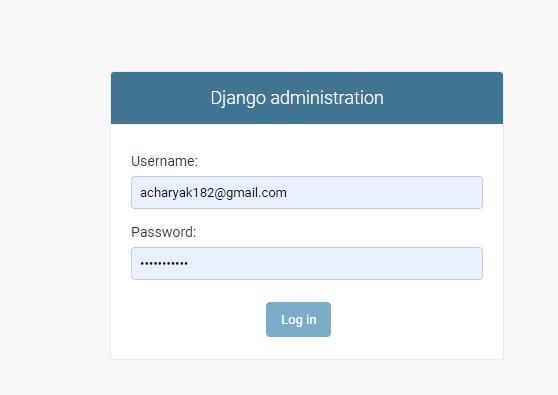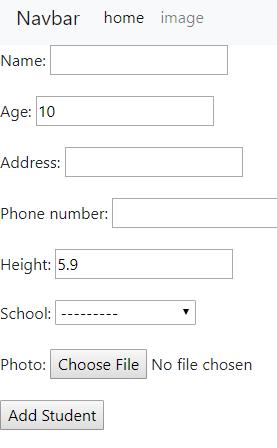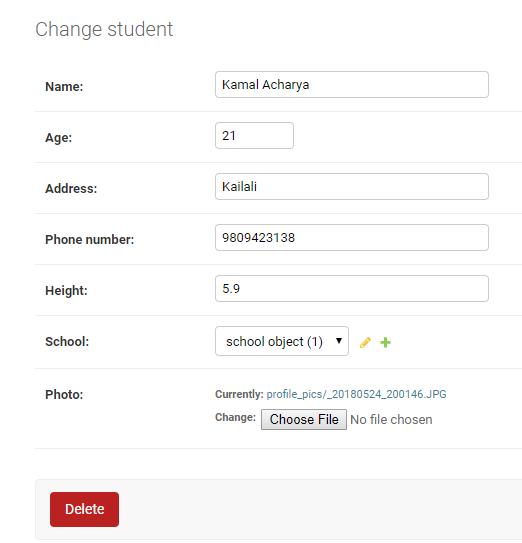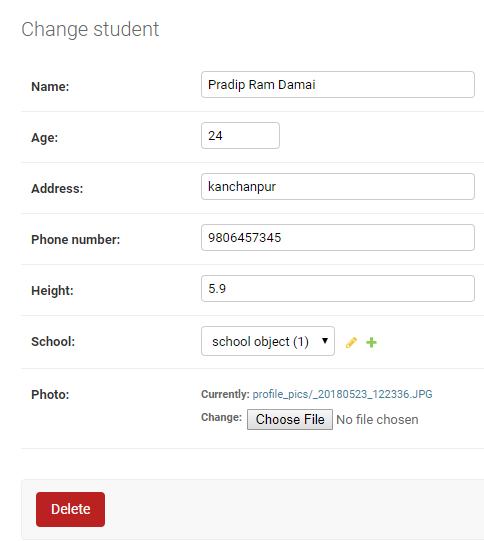Chapter 1 INTRODUCTION
The "Student Information Management System" is prepared or operates to maintain the records of student in school as well as in college. Student Information Management System deals with the all the activities done by computers such as registration admission process online , and staff and class management etc all these process are handled by the computer management system. The student record can be maintained online for the distance accessible to the entire student and their parents. Without the student management system managing and maintaining the details student is tedious job for any organization. Student information system will store all the detailed of the students including their background information, educational qualifications, Personal details and all the information related to their resume.
Suppose we have 1000 of student from this we have to search a particular student we know the name of the student. In a manual system it is a tedious task through we know the name of student but using the module we can easily search the student by specifying the name of student in the search criteria. Thus module will help the administrator in searching the student with the various criteria. This student management system also contained the registration module and account management. This module will help the student get registered from anywhere if the internet is present. This module really simplifies the works on paper registration. Also after successful registration the user can update information and changed their password as when required
This student management system also contained the user module. This module will help administrator enabling and disable a user account and change their password when they required.
1
Chapter 2 PROBLEM STATEMENT
The current system of any college is manual paper based system. This manual system is very difficult to maintain the information of student. It is a very tedious system and time consuming. To overcome all these problems we have to decide to make the computerized student information management system which help to manage the student record electronically toreplace the paper based system.
2
Chapter 3 OBJECTIVE OF THE PROJECT
The objective of the student information management system is to allow the administrator or any organization to edit and find the personal details of student and allow the student to keep upto date his profiles. It also facilities the keeping all records of student, such as their id, name milling address, phone number, DOB etc. So all the information about an student will be available in few seconds. Overall it'll make the student information management an easier job for administrator and the student of any organization. The main of SIMS document is to illustrate the illustrate the requirement of the project student information system and intended to help any organization to maintained and manage the student personal data.
3
Chapter 4 SCOPE OF THE PROJECT
The Student Information Management System(SIMS) can be enhanced to include some other functionality like marks, attendance management.
Talent management of the student based on their performance evaluation can be added.
Social networking can also be added where in student can interact with each other.
Online class functionality can be added.
Can evolve as an online institution.
Functionality of chat and message can be added.
online exam functionality can be added.
online resume builder can functionality can be also added.
4
Chapter 5
REQUIREMENT ANALYSIS AND FEASIBILITY STUDY
This is the most important phase of any project. The success or failure of the project highly depends on this phase. A good analysis and feasibility study leads to the success of the system.
5.1.1 REQUIREMENT ANALYSIS
Requirements analysis, also called requirements engineering, is the process of determining user expectations for a new or modified product. Project analysis is the process of collecting and analyzing the requirements of the project to be developed
Effective requirements analysis includes four type of activity:
Requirements Elicitation : The elicitation activity consists of understanding the user's need and gathering information and high level requirements.
Requirements Analysis : The analysis activity examines the high level requirements and determines if they are clear, complete, and free of contradictions, and then defines the strategy to address these issues.
Requirements Specification: The specification activity defines the behavior of a system in development and determines the method for requirements documentation.
Requirements Validation: The validation activity involves sessions with users, stakeholders, and functional experts to determine issue resolution plans for conflicting requirements before projects move into the development phase.
we studied various mobile websites and obtain different information and gain idea to build our system. Depending upon the nature as well as sources of information, we collected data from various websites such as www.slideshare.in, www.wikipedia.com, etc. and obtained the information.
5
5.1.2 FEASIBILITY STUDY
A feasibility study is an evaluation and analysis of the potential of the proposed project which is based on extensive investigation and research. Feasibility study is an analysis of the ability to complete a project successfully, taking into account legal, economic, technological and other factors. It allows investigating the possible negative and positive outcomes of a project before investing too much time and money. The objective of a feasibility study evaluates the project's potential for success. There are mainly three types of feasibility which are described as below:
5.1.2.1 TECHNICAL FEASIBILITY
Technical Feasibility assesses the resources and technology, which are required to accomplish user requirement in the software within the allocated time Technical feasibility considers the technical requirements of the proposed project. It deals with:
Whether the required technology is available or not.
Whether the required resources such as software and hardware are available or not.
Is relevant technology mature enough to be easily applied to our problem?
What kind of technology will we need?
Is the proposed technology or solution practical ?
Do we possess the necessary technical expertise? Minimum requirements to run this system:-
Hardware:-256MB RAM or above, Celeron processor,40GB hard disk or above.
Software:-Windows 2000/XP/VISTA/7,tomcat server, XAMPP(for Myself).
These resources were easily obtained. Hence the project is technically feasible.
6
5.1.2.2 OPERATIONAL FEASIBILITY
Operational feasibility is dependent on human resources available for the project and involves projecting whether the system will be used if it is developed and implemented. Operational feasibility is a measure of how well a proposed system solves the problems. This aspect defines the urgency of the problem and the acceptability of any solution. It also focuses on whether the required manpower is available or not to operate the system. The operational study includes people-oriented and social issues: internal issues, such as manpower problems, labor objections, manager resistance, organizational conflict and policies; also external issue, including social acceptability, legal aspects and government regulations. It takes in consideration whether the current work practices and procedures support a new system and social factors of how the organization changes will affect the working lives of those affected by the system. It deals with:
Does this project requires some investment in tool, skill levels, hiring, and infrastructures?
Do we have the right mix of team to take up this project? Our project mainly requires internet and computer to carry out the operation, which were easily obtained. Hence it is operationally feasible.
5.1.2.3 ECONOMIC FEASIBILITY
Economic feasibility could also referred to as cost/benefit analysis. It is the most frequently used method for evaluating the effectiveness of new system. It is the bottom line for many projects it specifies:
Is the system cost effective?
The cost of doing full system study.
can the project be done, within cost constraints?
What is the minimal cost to attain a certain system?
The cost may be of following category:
Computer cost : Rs(18000-20000)
Router cost : Rs 2500
Internet cost : Rs1000 per month
Website cost : Rs 7000
Website registration cost : Rs(4000-5000)
Maintenance cost : Rs 1000 per year
Total cost : Rs(33500-36500)
Through the initial cost is a little bit more but was affordable. Hence the project is economically feasible.
7
Chapter 6 SYSTEM DESIGN
6.1.Introduction
6.1.1 Scope and purpose
The purpose of the design phase is to develop a clear understanding of what the developer want people to gain from his/her project. As you the developer work on the project, the test for every design decision should be "Does this features fulfill the ultimate purpose of the project?" A purpose statement affects the design process by explaining what the developer wants the project to do, rather than describing the project itself. The design document will verify that the current design meets all of the explicit requirements contained in the system model as well as the implicit requirements desired by customer.
6.1.2 Overall System Design Objectives
The overall system design objective is to provide an efficient, modular design that will reduce the system's complexity, facilitate change and result in an easy implementation. This will be accomplished by designing strongly cohesion system with minimal coupling. In addition, this document will provide interface design models that are consistent user friendly and will provide straight forward transition through the various system functions.
6.1.3 Structure Of Design Document
System Architecture Design – The System architecture section has detailed diagram of the system, server and client architecture.
Data Design – The data design include an ERD as well as database design.
6.2. System Architecture Design
6.2.1 System Architecture
8
jh Student information Management j Maintaining student detail jjjjjjjjjjjhh Search student detail
Fig. System Architecture
The SMIS is a system which contains major part which include : student detail, student image and resume. The user selects one of the available options as an input to the system. According to the input by the user the system acts and the rest of the functions are performed accordingly. The administrator can operate on any student details. But the normal student or users can only access their details of all the functionalities.
9
6.3.1 Entity Relationship Diagram
Fig: Entity Relationship Diagram
Login Granted Request To Edit Request To View
6.4.2 Data flow diagram Request To Login
Request To View
nLo Login dddddd id roll no Manages jd Administrator S Student name Password city pcount standard image Administrator Student Database Administrator Module process Student Module
Fig: Dataflow Diagram
Process
6.4.2 Decision Tree
6.4 USE CASE MODULE
10
Request for login Login Failed Admin Login Request to view
Admin Student
USE
MODULE Home Student Login View Administrator Home Student Detail Search Student Detail Display Student e Detail Edit Student Detail View Student Information View Student Information Edit Student Information Search Specific Student
Fig:
CASE
6.5 USE CASE DIAGRAM FOR LOGIN ["Log In" Selected]
6.6 USE CASE FOR STUDENT DETAIL. [Display Student Selected] [Exit
Use Case Report-Display Student Details
11
Fig: DFD Login
Selected]
[Record Does Not Exist] [Success]
Redirect to Main Menu Student Details Displayed Enter A Search Key Display Student
6.7 USE CASE DIAGRAM FOR EDIT
[Invalid User_id or Password]
Login To The Websites
View/Edit the Details
Database Updated
Fig :USE CASE DIAGRAM FOR EDIT
12
Chapter 7 IMPLEMENTATION
An implementation is a realization of a technical specification or algorithm as a program, software component or other computer system through programming. Many implementation may exist for a given specification or standard. Implementation is the process of converting new system design into specification or standard. Implementation is the process of converting new system design into operational mode. It consist of mainly two activities:
Conversion
Installation
7.1 Conversion
Conversion means changing from one system to another system. The objective is put the tested system into operation. It involves:
Creating computer compatible file.
Training the operating staff.
Installing terminals and hardware.
7.2 Installation
The process of moving from current system to new system is called installation . There are several different approach to install a system:
7.2.1 Direct installation:
Changing the old system to new system by turning off the old system when the system is turned on
7.2.2 Parallel installation:
Running the old system and old system at the same time until the management decides the old system can be turn off.
7.2.3 Phased installation:
Phased installation is an incremental approach. With phased installation; one function component of new system is installed with next functional component of old system until the whole system is installed. For this project we used direct installation.
13
Chapter 8 TESTING
Testing means checking if a program for the specific inputs gives correctly and expected results. Testing is a process of executing a program with the goal of finding errors. So, testing means that one inspects behavior of a program on a finite set of test cases. Testing can be stated as the process of validating and verifying that a computer program/application/product:
Meets the requirements that guided its design and development,
Works as expected.
There are two types of testing i.e Black Box Testing and White Box Testing.
8.1 White-box Testing:
White-box testing (also known as clear box testing, glass box testing, and transparent box testing and structural testing) is a method of testing software that tests internal structure or workings of an application. In white-box testing an internal perspective of the system, as well as programming skills, are used to design test cases. The tester chooses inputs to exercise paths through the code and determine the appropriate outputs.It is testing of the structural internals of the code. In this testing, the internal structure/design/implementation of the items being tested is known to the tester.
8.2 Black-box Testing:
Internal workings of the software itself. Only inputs and outputs are examined. Black box testing id often referred to as behavioral testing, in the sense that we want to test how the software behaves as a whole. It is mainly applicable to higher levels of testing i.e Black-box testing is a way of testing software without having much knowledge of the Acceptance Testing and System Testing. It focuses on functionality of system. For our project we used white box testing. This project has checked the possible errors such as:
Test Case: This test will check the application "Login Form".
Test Procedure: To login enter username and password.
Expected Result: If login is validated we are allowed to go to next page.
14
Actual Result: Next page show the main menu page where different task can be performed.
The software will definitely undergo change once it is delivered to the customer. There can be many reasons for this change to occur. Change could happen because of some unexpected input values into system. In addition, the changes in the system could directly affects the software operations.
In general, software remains operational for an extended period of time after initial implementation and requires regular maintenance to ensure that the software operates continuously at peak performance levels. Maintenance tasks are typically performed by the designers of the software to address issues discovered after deployment of the software program. The Maintenance and Support is a format project lifecycle phase used to regularize and institutionalize changes.
Maintenance refers to all modification operations carried out on operational software, leaving its basic functionalities intact. Corrective maintenance consists of correcting errors of the system, and upgrade maintenance consists of modifying the system to add new functionalities.
15
Chapter 10 CONCLUSION AND ENHANCEMENT:
With the successful implementation of this project will remove the manual system used by various school administrations. It helps to keep the records of student in the database and easy to add and search the student detail. This project also can be enhancement to maintain the salary of staff and fee of the student. This will take few time and economical for the school.
Some code of the project
Source code
Student_List.html
<!DOCTYPE html>
<html lang="en">
<head>
<meta charset="UTF-8">
<title>Title</title>
</head>
<body>
{% extends 'base.html' %}
{% block body_block %}
{% if messages %}
{% for msg in messages %}
<div class="alert alert-{{ msg.tags }}">
{{ msg }}
</div>
{% endfor %}
{% endif %}
<th>Name</th>
<th>Age</th>
<th>address</th>
<th>School</th>
<th>Delete</th>
<th>Edit</th>
<th>Photo</th>
</tr>
{% for student in students %}
16
<table> <tr> <th>id</th>
<tr>
<td>{{student.id}}</td>
<td>{{student.name}}</td>
<td>{{student.age}}</td>
<td>{{student.address}}</td>
<td>{{student.school}}</td>
<td><a href="{% url 'delete_student' id=student.id %}">Delete</a></td>
<td><a href="{% url 'edit_student' id=student.id %}">Edit</a></td>
<td>
{% if student.photo %}
<img src="{{student.photo.url}}" alt="doesn't exit" height="50px">
</td>
{% endif %}
</tr>
{% endfor %}
</table>
</body>
School_List.html
<!DOCTYPE html>
<html lang="en">
<head>
<meta charset="UTF-8">
<title>Title</title>
</head>
<body>
<table>
<tr> <th>id</th>
<th>Name</th>
<th>address</th>
</tr>
{% for school in schools %}
<tr>
<td>{{school.id}}</td>
17
<td>{{school.name}}</td>
<td>{{school.address}}</td>
</tr>
{% endfor %}
</table>
</body> </html>
Edit_student.html
<!DOCTYPE html>
<html lang="en">
<head>
<meta charset="UTF-8">
<title>Title</title>
</head>
<body>
{% extends 'base.html' %}
{% block body_block %}
<form method="POST" enctype="multipart/form-data">
{% csrf_token %}
{{ form.as_p}}
<input type="submit" value="Save changes">
</form>
{% endblock %}
</body> </html>
Contact_us.html
<!DOCTYPE html>
<html lang="en">
<head>
<meta charset="UTF-8">
<title>Title</title>
</head>
<body>
{% extends 'base.html' %}
{% block body_block %}
<form method="post">
{% csrf_token %}
18
{{ form }}
<input type="submit" value="submit">
</form>
{% endblock %}
</body> </html>
Base.html
<!DOCTYPE html>
{% load staticfiles %}
<html lang="en">
<head>
<meta charset="UTF-8">
{% block title %}
{% endblock %}
<link href="{% static 'css/bootstrap.min.css' %}" rel="stylesheet" type="text/css">
</head>
<body>
<nav class="navbar navbar-expand-lg navbar-light bg-light">
<a class="navbar-brand" href="#">Navbar</a>
<div class="collapse navbar-collapse" id="navbarSupportedContent">
<ul class="navbar-nav mr-auto">
<li class="nav-item active">
<a class="nav-link" href=" "> home </a>
</li>
<li class="nav-item">
<a class="nav-link" href=" url 'app2_index'}">image</a>
</nav>
{% block body_block %}
{% endblock %}
</body> </html>
19
</li> </ul> </div>
Snapshot Database Tables:

In database:

20
Django Administration

21



22


23
REFRENCES AND BIBLIOGRAPHY
Programming with python A prime 3e (E.Balagurusamy),The McGraw Hill Companies
Pressman, R.S(2014).,"Software Engineering – A Practitioner's Approach", 8th Edition, New Delhi,McGraw Hills
LethbridgeTimothy and LaganiereRobert (2010). Object-oriented software Development using UML.New Delhi, McGraw Hills
Jeffrey L.Whitten, Lonnie Bentley, System analysis and design methods,5th Edition,Mc-Graw Hill
Jeffery A. Hoffer, Joey F.George, JosephS.valacich,Modern Systems Analysis and Design,7th Edition, Person Education
Silberschatz, H.F. Korth, and S.Sudarshan, Database System Concepts, 6th Edition, McGraw Hill, 2010 www.google.com
www.slideshere.com.inS
Some Hindi YouTube channel
www.w3schools.com
24








